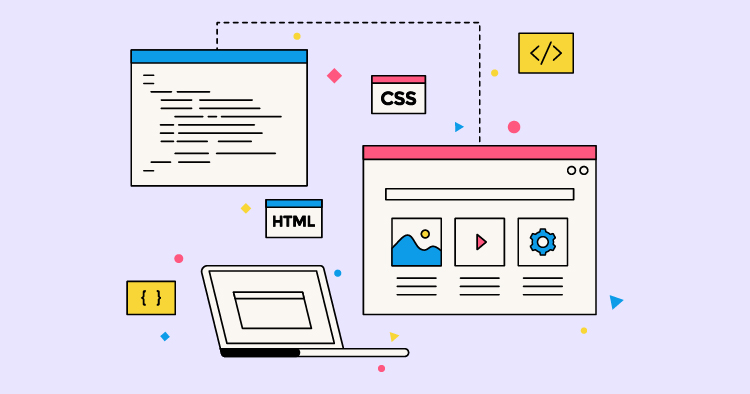Understanding the web development stack is essential for any business aiming to build or improve its online presence. Think of it as a stack of building blocks that includes all the software technologies needed to create and run websites and web applications. The stack has different layers, each with its purpose. The front end is what users see and interact with, while the back end includes servers and databases that handle all the behind-the-scenes processing. Knowing how these parts fit together is crucial for making smart decisions about the digital tools your business requires to thrive on the web.
Understanding the Web Development Stack
Think of the web development stack as a toolbox with tools that web developers use to build websites and web applications. Like any good toolbox, it includes tools for various tasks: creating the visible parts of a website you interact with (the front end) and handling the behind-the-scenes processes like databases and server management (the back end).
When developers choose their tools, they consider the website’s needs, the number of people who will use it, and the skills of their team. Some popular tools include programming languages like JavaScript and Python. Frameworks like React or Ruby on Rails help structure the development process, as do databases like MySQL or MongoDB and servers like Apache or Nginx.
The Role of Front-End Development
Front-end development is about what you see and interact with on a website. It’s the job of front-end developers to create a smooth and engaging experience for users. They use HTML to lay out the content, CSS to make it look appealing, and JavaScript to add many interactive features.
One key goal of front-end development is to ensure that websites work well on various devices. This is where responsive design comes in. It’s a way of building sites that automatically adjust and look great, whether viewed on a large desktop monitor or a small phone screen. This adaptability is crucial because it means everyone gets a great experience, regardless of how they access the site.
Back-End Development
Back-end development is all about what happens behind the scenes of a website. Developers build and maintain the website’s technology, including the server, application, and database. It’s essential to ensure everything on the front end, which users interact with, works properly.
Developers use programming languages like PHP, Python, and Ruby to write the code that allows websites to process information. Developers ensure secure and efficient handling of data sent from the user’s browser and work on storing and retrieving a website’s data.
Databases are central to back-end development. Back-end developers use databases as a central component where they store all the data, and it is crucial to manage this data effectively. If the database is slow or insecure, it can cause critical problems for a website.
Select one of over 500 designs and establish your online presence.
- Free Web Hosting
- Fully Managed Solutions
- Scalable Websites
- No Hidden Cost
Full-Stack Development
Full-stack development is the ability to work on a website’s front and back ends. In the tech world, full-stack developers are like Swiss Army knives because they have a wide range of skills that cover everything from user interface design to server and database management.
To be a full-stack developer, you must know languages like HTML, CSS, and JavaScript for the front end. You’ll also need to be proficient in back-end languages and database management. Understanding design and managing the different versions of your code is also essential.
For small businesses, hiring a full-stack developer can be a smart move. It means you have one person who can handle various tasks, from designing your site to ensuring it runs smoothly. This can save money and simplify communication. But remember, while they can do a lot, they might not have the same deep expertise in one area as a specialist.
Content Management Systems (CMS)
Content management systems are essential for building and maintaining a website without deep technical knowledge. They provide a user-friendly way to manage your website’s content, such as adding blog posts, updating product pages, or changing your site’s design without writing or editing code.
WordPress and Joomla are two popular CMS choices among small businesses. They’re loved for their simplicity, wide range of design options, and vast plugins that can add new features to a website. Whether you’re looking to add a contact form, improve SEO, or open an online store, there’s likely a plugin that can help.
When picking a CMS, consider what’s most important for your business. Do you need something straightforward and easy to use, or are you looking for many customization options? Consider how your content will grow over time and whether the CMS can grow with you. A well-chosen CMS can be a powerful ally for a small business, letting you keep your website fresh and engaging with less technical help.
Web Hosting and Deployment
Web hosting is where your website lives on the internet. It’s how you store your site’s files so people can visit and interact with it whenever they want. The type of hosting you choose is necessary because it affects how quickly your website loads, how often it’s available, and how much traffic it can handle.
Small businesses have several hosting options. Shared hosting is like renting a room in a house with others—it’s affordable and might be all you need starting. Virtual private servers offer more space and control, like an apartment in a building. Dedicated servers are like having a house with complete control and responsibility.
Deploying your website is just the first step. Keeping it running smoothly means regularly updating it, creating backups, and checking for security issues. It’s also good to monitor its performance. Are pages loading quickly? Is everything working as it should be? Staying on top of these tasks means your website can support your business effectively and securely.
Select one of over 500 designs and establish your online presence.
- Free Web Hosting
- Fully Managed Solutions
- Scalable Websites
- No Hidden Cost
Security and Maintenance
For small businesses, keeping a website safe is critical. It’s not just about safeguarding your data but protecting your customers’ information. This builds trust and maintains your reputation.
Malware, phishing, SQL injection, and cross-site scripting are all too common. To fend off these threats, you must install SSL certificates to encrypt data, enforce strong password rules, update your software regularly, and use trusted security plugins.
But it’s not just about setting up defenses and walking away. Regular maintenance keeps your website in top shape. This means updating your content, fixing any broken links, keeping software and plugins current, and backing up your data. You should also look for any odd activity that might signal a security issue so you can deal with it quickly.
Search Engine Optimization (SEO)
SEO is all about getting your website seen by more people without having to pay for ads. When your site shows up higher in search results, you’re more likely to get clicks from potential customers.
To improve your SEO, start with the basics: use relevant keywords in your content, make sure your site loads quickly, and ensure it’s easy to use on mobile devices. Getting other reputable websites to link to yours can also help a lot. Plus, having a website that’s easy to navigate and understand is essential.
Consider how your technology can help with SEO when building or updating your website. Some tech choices can lead to faster loading times, which search engines love. Clean code that search engines can easily read is also a plus. And if you’re using a content management system (CMS), ensure it makes following SEO best practices simple.
Mobile Optimization
Mobile optimization is essential because many people use their smartphones to browse the internet. When a website is mobile-optimized, it’s more user-friendly, which can lead to more people staying on the site longer and, ultimately, more people taking the actions you want them to take, like making a purchase or signing up for a newsletter.
There are two main approaches to making a website mobile-friendly: responsive design and mobile-specific design. Responsive design means your website adjusts to look good on any device, whether a desktop, a tablet, or a smartphone. This is a popular choice because it’s easier to maintain and ensures everyone has the same experience on your site, no matter their device. Developers create mobile-specific websites specifically for mobile phones. While this can offer a highly tailored mobile experience, it can also mean more work because you maintain two separate websites.
To ensure your website works well, start designing for mobile first. This means thinking about how your site will function on a smaller screen. Also, make sure your images and content load quickly on mobile devices and that buttons and links are easy to use with a touchscreen.
Analytics and Conversion Tracking
Knowing how your website performs and understanding what users do when they visit is crucial for any business. Analytics tools, like Google Analytics, help you see how people interact with your site, which parts they like best, and where they might get stuck and leave.
You can integrate these tools into your web development process to get a detailed look at user behavior. They show essential information like the number of people visiting your site, how long they stay, and what devices they use. This data can help you make informed decisions about improving your website.
Conversion tracking is about understanding how well your website does its job. You can see how often conversions occur by setting goals, like a user making a purchase or signing up for a newsletter. This helps you determine what’s working well and what might need to be tweaked to make your website even more effective at meeting your business goals.
Final Thoughts
Picking the right web development stack is a big decision that can shape your business’s online performance. It’s wise to consider how well the stack can grow with your company, how secure it is, and whether it aligns with your goals. You can build an effective online presence by getting to grips with the different parts of the stack and how they work together. Plus, keeping up with new trends and technologies in web development can help your business stay competitive and ready to evolve in a digital marketplace that’s constantly changing.



